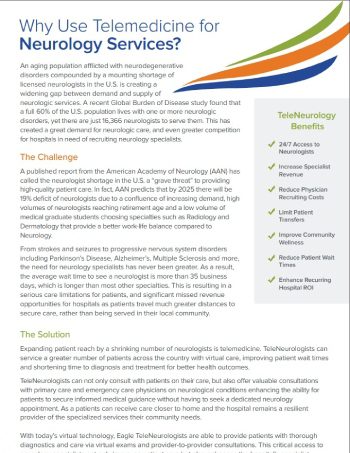Tele-Neurology Services
The average wait time to see a neurologist is more than 35 business days. Telemedicine has the power to improve patient wait times and shorten time to diagnosis and treatment for better health outcomes.
An aging population afflicted with neurodegenerative disorders compounded by a mounting shortage of licensed neurologists in the U.S. is creating a widening gap between demand and supply of neurologic services. A recent Global Burden of Disease study found that a full 60% of the U.S. population lives with one or more neurologic disorders, creating a great demand for neurologic care, and even greater competition for hospitals in need of recruiting neurology specialists.
TeleNeurologists can not only consult with patients on their care, but also offer valuable consultations with primary care and emergency care physicians on neurological conditions enhancing the ability for patients to secure informed medical guidance without having to seek a dedicated neurology appointment. As a patients can receive care closer to home and the hospital remains a resilient provider of the specialized services their community needs.
TeleNeurology Benefits
- 24/7 Access to Neurologists
- Increase Specialist Revenue
- Reduce Physician Recruiting Costs
- Limit Patient Transfers
- Improve Community Wellness
- Reduce Patient Wait Times
- Enhance Recurring Hospital ROI
Remote Study Interpretation Services
EEG's
An EEG is a test that detects abnormalities in your brain waves, or in the electrical activity of your brain. During the procedure, electrodes consisting of small metal discs with thin wires are pasted onto your scalp. The electrodes detect tiny electrical charges that result from the activity of your brain cells.
Sleep Studies
Sleep studies, also called polysomnography, are painless tests that measure how well you sleep and how your body responds to sleep problems. They are also used to help your doctor diagnose sleep disorders.
